- With standard equipment
- With safety pack
Find more information in the General Comments section of the assessment
Find more information in the Rating Validity tab of the assessment
- See More
- See More
- See More
- See More
- Good
- Adequate
- Marginal
- Weak
- Poor
 Passenger
Passenger
 Driver
Driver
 Rear Passenger
Rear Passenger
 Driver
Driver
 Car
Car
 Pole
Pole
 Rear Seat
Rear Seat
 Front Seat
Front Seat
- Good
- Adequate
- Marginal
- Weak
- Poor


Passenger
outboard
Fitted to the vehicle as standard
Not fitted to the test vehicle but available as option
Not Available
-
i-Size CRS
-
ISOFIX CRS
-
Universal Belted CRS
Easy
Difficult
Safety critical
Not allowed
| Seat Position | |||
|---|---|---|---|
| Front | 2nd row | ||
| Passenger | Left | Right | |
| Maxi Cosi 2way Pearl & 2wayFix (rearward) (iSize) | |||
| Maxi Cosi 2way Pearl & 2wayFix (forward) (iSize) | |||
| BeSafe iZi Kid X2 i-Size (iSize) | |||
| Maxi Cosi Cabriofix & FamilyFix (ISOFIX) | |||
| BeSafe iZi Kid X4 ISOfix (ISOFIX) | |||
| Britax Römer Duo Plus (ISOFIX) | |||
| Britax Römer KidFix XP (ISOFIX) | |||
| Maxi Cosi Cabriofix (Belt) | |||
| Maxi Cosi Cabriofix & EasyBase2 (Belt) | |||
| Britax Römer King II LS (Belt) | |||
| Britax Römer KidFix XP (Belt) | |||
Easy
Difficult
Safety critical
Not allowed
In the frontal offset test, protection of the chest of the 6-year dummy was rated as marginal while that of all other body areas was good or adequate for both dummies. In the side barrier test, protection of all critical body regions was rated as good. The front passenger airbag can be disabled to allow a rearward-facing child restraint to be used in that seating position. However, the information provided to the driver regarding the status of the airbag is not sufficiently clear, and the system was not rewarded. Accordingly, rearward-facing restraints failed the installation check for the front passenger seat. In addition, the owner's manual indicates that ISO/R3 restraints are not suitable for the rear outboard seats. Otherwise, restraints could be properly installed and accommodated.
- Good
- Adequate
- Marginal
- Weak
- Poor

Head Impact 9.3 Pts
Pelvis Impact 6.0 Pts
Leg Impact 5.0 Pts
The protection provided by the bonnet to the head of a struck pedestrian was no better than adequate and was poor in many test areas. Protection of pedestrians' legs was predominantly adequate while that of the pelvis was good.
- Good
- Adequate
- Marginal
- Weak
- Poor
| Applies To | All seats | ||
| Warning | Driver Seat | Front Passenger(s) | Rear Passenger(s) |
| Visual | |||
| Audible | |||
|
|||
The e-Mehari as a seatbelt reminder system for the front and rear seats. Otherwise, it has no driver assistance features that qualify for assessment by Euro NCAP.
- Specifications
- Safety Equipment
- Videos
- Rating Validity
Specifications
Tested Model Citroën e-Mehari, LHD
Body Type - 3 door hatchback
Year Of Publication 2017
Kerb Weight 1483kg
VIN From Which Rating Applies - all e-Meharis
Class Small Family Car
Safety Equipment
Note: Other equipment may be available on the vehicle but was not considered in the test year.
Fitted to the vehicle as standard
Fitted to the vehicle as part of the safety pack
Not fitted to the test vehicle but available as option or as part of the safety pack
Not available
Not applicable
Videos
Rating Validity
Variants of Model Range
| Body Type | Engine | Drivetrain | Rating Applies | |
|---|---|---|---|---|
| LHD | RHD | |||
| 3 door hatchback | 50kW electric* | 4 x 2 |  |
N/A |
* Tested variant

Find more information in the General Comments section of the assessment
 Share
Share
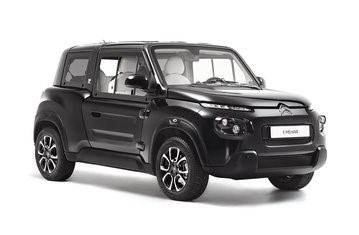
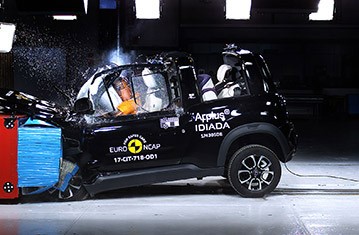
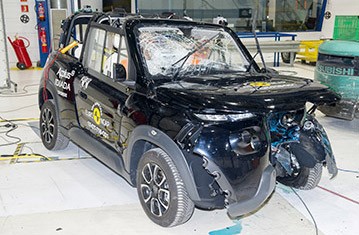
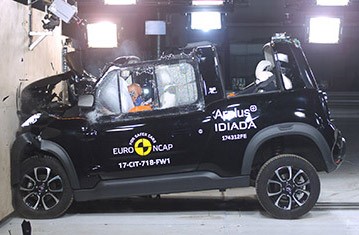
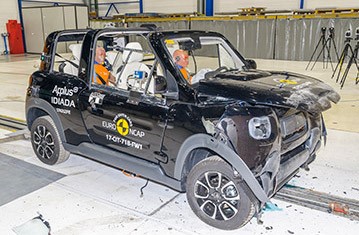
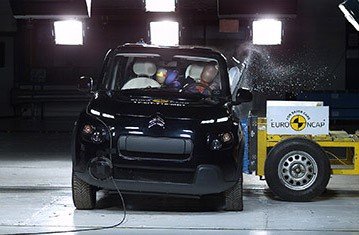
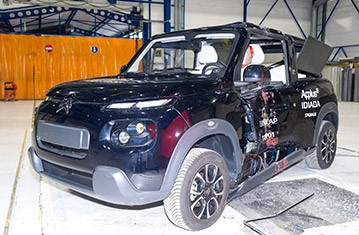



The passenger compartment of the e-Mehari remained stable in the frontal offset test. Dummy readings indicated good protection of the knees and femurs of the driver and passenger. However, structures in the dashboard were considered a risk to the knees and femurs of occupants of different statures and to those sat in different positions, and the score was penalised. In the full-width rigid barrier test, protection of all critical parts of the body was good or adequate for both the driver and the rear passenger. In the side barrier impact, protection of all critical body areas was good and the e-Mehari scored maximum points. In the more severe side pole impact, dummy readings of rib compression indicated marginal protection of the chest, but that of the rest of the body was good. Tests on the front seats and head restraints demonstrated marginal whiplash protection in the event of a rear-end collision. A geometric assessment of the rear seats indicated poor whiplash protection there.